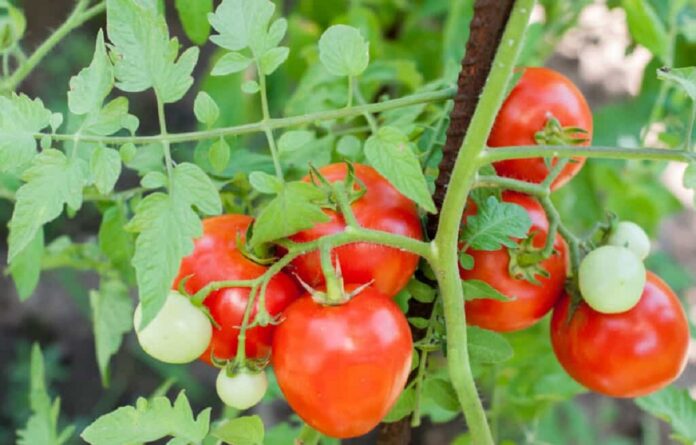Tomato production is one of the major agricultural activities in Ghana. Tomatoes production in Ghana has reached levels in the region of 400,000 metric tonnes while the consumption is way above that. It is, therefore, a very profitable venture but has its own challenges.
But before you venture, don’t you think it is better to know everything about tomato production.
Botanical name
Lycopersicon esculentum (L)
Suitable varieties
Roma VFN, Pectomech VF, Tropimech, Rio Grande, Jaguar, Lindo, Titao Derma, Ada Cocoa.
There are several other very productive ones also. See your trusted and certified seed dealer.
Source of planting material
Buy certified seeds from reputable seed companies.
Read also: Complete Guide to Okra Production in Ghana
Climatic requirements/Site selection
Tomato requires warm days, bright sunshine and cool nights for optimum yields. High temperatures and low humidity cause excessive flower drop and reduce yields drastically. Soils should be well-drained and fertile.
Land preparation
In tomato production, thorough land preparation is important in enhancing early crop establishment and adequate weed control. Incorporation of well-decomposed poultry manure at the rate of 25ton/ha at land preparation may be beneficial. Prepare ridges or bed across the contours on which seedlings may be transplanted. Construct a farm pond to collect excess water and reuse for irrigation.
Read also: Experts’ Guide to Chilli Production in Ghana
Propagation
Seeds can be sown in seedbeds in seed trays or seedboxes. Prepare seedbeds at 1.2m wide and at any convenient length and then level beds. Water beds, cover with dry grass. Burn or solarize soil with transparent plastic sheets for 5-8 weeks to sterilize the soil.
Sow seeds in drills 10cm apart. Cover beds with well dried non-seeded grass or palm fronds. After emergence, remove dry grass. Provide shade over the bed. Thin out weak, mal-formed seedlings to avoid overcrowding. Prick out seedlings at first true leaf stage. Transplant seedlings 3-4 weeks after emergence on the field at the 5-leaf stage. Two weeks before planting on the field, apply a liquid feed of 5g/L of NPK 15-15-15. Harden seedlings 1 week before transplanting. Do this by decreasing shade until at least 1-day full exposure to sunlight and/or reducing irrigation.
Planting
Transplant preferably late in the afternoon. Plant 60×30 cm in the dry season and 60×60 cm in the wet season.
Read also: Experts’ Guide to good Garden Eggs Production in Ghana
Seed rate
300g to 450g per ha. Do a germination test to avoid wasting seeds and time.
Weed control
Timely weed control is necessary for healthy crop growth. This may be achieved by frequent shallow hoeing. Application of pre-emergence weedicides 3-4 days before transplanting will enhance weed control.
Irrigation in tomato production
Water supply is very important, especially in the dry season. The most critical time for ample soil moisture is during bloom and early fruiting stages.
Read also: Detailed Guide to Ginger Production in Ghana
Nutrient requirements
For a yield of 40 tons/ha, tomato requires about 96kg of N,16kg of P2O5, 144kg of K2O, 68kg of Ca, 24kg of Mg and 24kg of S.
Fertilizer application
Use soil test as a guide to fertilizer application. The table below is a general recommendation for tomato production.
| Weeks after Transplanting | Rate of Application |
| 2&3 split application | 400kg NPK/ha |
| 4-5 | 100kg/ha Potassium Nitrate |
| 6-8 split application | 100kg/ha Sulphate of Ammonia |
Application of commercial foliar sprays with an adequate amount of Boron and Manganese would enhance crop quality and yield.
Pests and Diseases Control
Major pests in tomato production are aphids, grasshoppers, whiteflies, crickets, leaf miners, beetles, mites and caterpillars. Control with the application of potassic soap solution (alata samina) at 5g/L, insecticidal soaps or recommended insecticides.
Major diseases affecting tomatoes at pre-planting and later stages include:
Damping-off: Attacks seedlings on nursery beds. Control by selecting well-drained areas for the nursery and regulate irrigation. Solarize the soil for 4-6 weeks before planting, or apply recommended fungicides e.g. copper-based fungicides.
Early blight: Attacks seedlings at the seedbed stage. High temperatures may favour disease incidence. Use disease-free seeds and prick out into individual containers.
Septoria leaf spot: Attacks the plant at any stage. Under heavy infection, spots occur on the stems and flowers. Control by burning all tomato remains after harvest. Practice crop rotation with cereals and legumes or use fungicides.
Sclerotium wilt: Attacks the base of the tomato stem. Affected plants show drooping leaves and finally complete wilt. Control by crop rotation, good field sanitation. Also by the use of recommended fungicides.
Root-knot nematode: Nematodes feed on young root causing wilt and thus reducing fruit yield. It can be controlled by applying recommended nematicides. Use tolerant varieties. Practise crop rotation using cereals. Alternatively, apply well-decomposed poultry manure.
Harvesting
Fruits are harvested at the mature green stage or fully ripe but firm stage depending on market demand and distance. Sort and pack in 52kg stackable wooden crates lined with foam/dry straw or 40kg stackable crates.
Read also: Importance of Farm Records Keeping
Yield
Yield varies greatly with cultivar. And also adherence to good agricultural practices. Yields of up to 35-40 tons/ha are achievable.
Market requirement
The fruit should be firm and free from blemishes or any damage.
Read also: 7 Tips on Profitable Farming with Good Records Keeping
Reference
Featured Image Source: Tennessee Magazine


